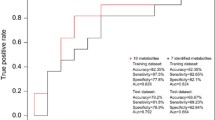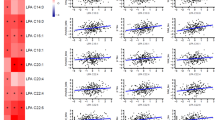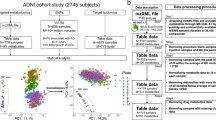Abstract
Introduction and objective
Mild cognitive impairment (MCI) is considered to be a prodromal stage of Alzheimer’s disease (AD), which is the most common type of dementia. Although MCI is a common clinical manifestation in the elderly, the pathology and molecular mechanisms are not fully understood. Oxylipins are a major class of lipid-derived signaling mediators, which have been implicated in the pathology of MCI and AD. In this study, we investigated the changes of oxylipin profiles in plasma of MCI patients.
Methods
We performed a targeted liquid chromatography—mass spectrometry analysis to quantify 49 oxylipins and 4 polyunsaturated fatty acids in plasma samples of 60 clinically diagnosed MCI patients and 56 age- and gender-matched cognitively normal individuals.
Results
We found that the levels of linoleic acid (LA) and 7 oxylipins were significantly altered in MCI patients when compared to the controls. Notably, oxylipins synthesized through 5-lipoxygenase (5-LOX) and cytochrome P450 (CYP450) pathways of arachidonic acid (AA) or LA were elevated in MCI patients, which is in accordance with previously reports that oxylipins from the same pathways were increased in the brain tissues of AD and MCI patients, suggesting the potential correlations of oxylipin changes in 5-LOX and CYP450 pathways between the peripheral blood and the brain tissues in MCI and AD patients.
Conclusion
This study is the first report on plasma oxylipin profiles in MCI patients, and disease-relevant changes of oxylipins and oxylipin pathways were identified. The results represent potentially an efficient method to monitor certain oxylipin changes in the brain tissues of MCI or AD patients.


Similar content being viewed by others
References
Albert, M. S., DeKosky, S. T., Dickson, D., Dubois, B., Feldman, H. H., Fox, N. C., et al. (2011). The diagnosis of mild cognitive impairment due to Alzheimer’s disease: recommendations from the National Institute on Aging-Alzheimer’s Association workgroups on diagnostic guidelines for Alzheimer’s disease. Alzheimer’s & Dementia, 7(3), 270–279. doi:10.1016/j.jalz.2011.03.008.
Boyce, J. A. (2008). Eicosanoids in asthma, allergic inflammation, and host defense. Current Molecular Medicine, 8(5), 335–349.
Capra, V., Back, M., Barbieri, S. S., Camera, M., Tremoli, E., & Rovati, G. E. (2013). Eicosanoids and their drugs in cardiovascular diseases: focus on atherosclerosis and stroke. Medicinal Research Reviews, 33(2), 364–438. doi:10.1002/med.21251.
Chu, J., & Pratico, D. (2011). 5-lipoxygenase as an endogenous modulator of amyloid beta formation in vivo. Annals of Neurology, 69(1), 34–46. doi:10.1002/ana.22234.
Crago, E. A., Thampatty, B. P., Sherwood, P. R., Kuo, C. W., Bender, C., Balzer, J., et al. (2011). Cerebrospinal fluid 20-HETE is associated with delayed cerebral ischemia and poor outcomes after aneurysmal subarachnoid hemorrhage. Stroke: A Journal of Cerebral Circulation, 42(7), 1872–1877. doi:10.1161/STROKEAHA.110.605816.
Czapski, G. A., Czubowicz, K., Strosznajder, J. B., & Strosznajder, R. P. (2016). The Lipoxygenases: Their regulation and implication in Alzheimer’s disease. Neurochemical Research, 41(1–2), 243–257. doi:10.1007/s11064-015-1776-x.
Feng, L., Chong, M. S., Lim, W. S., & Ng, T. P. (2012). The modified mini-mental state examination test: Normative data for Singapore Chinese older adults and its performance in detecting early cognitive impairment. Singapore Medical Journal, 53(7), 458–462.
Feng, L., Yap, P. L. K., Lee, T. S., & Ng, T. P. (2009). Neuropsychiatric symptoms in mild cognitive impairment: a population-based study. Asia-Pacific Psychiatry, 1, 23–27. doi:10.1111/j.1758-5872.2009.00005.x.
Gorelick, P. B., Scuteri, A., Black, S. E., Decarli, C., Greenberg, S. M., Iadecola, C., et al. (2011). Vascular contributions to cognitive impairment and dementia: a statement for healthcare professionals from the american heart association/american stroke association. Stroke: A Journal of Cerebral Circulation, 42(9), 2672–2713. doi:10.1161/STR.0b013e3182299496.
Ikonomovic, M. D., Abrahamson, E. E., Uz, T., Manev, H., & Dekosky, S. T. (2008). Increased 5-lipoxygenase immunoreactivity in the hippocampus of patients with Alzheimer’s disease. The Journal of Histochemistry and Cytochemistry: Official Journal of the Histochemistry Society, 56(12), 1065–1073. doi:10.1369/jhc.2008.951855.
Johnson, J. K., Pa, J., Boxer, A. L., Kramer, J. H., Freeman, K., & Yaffe, K. (2010). Baseline predictors of clinical progression among patients with dysexecutive mild cognitive impairment. Dementia and geriatric cognitive disorders, 30(4), 344–351. doi:10.1159/000318836.
Joshi, Y. B., Giannopoulos, P. F., & Pratico, D. (2015). The 12/15-lipoxygenase as an emerging therapeutic target for Alzheimer’s disease. Trends in Pharmacological Sciences, 36(3), 181–186. doi:10.1016/j.tips.2015.01.005.
Joshi, Y. B., & Pratico, D. (2014). The 5-lipoxygenase pathway: oxidative and inflammatory contributions to the Alzheimer’s disease phenotype. Frontiers in Cellular Neuroscience, 8, 436. doi:10.3389/fncel.2014.00436.
Kowianski, P., Lietzau, G., Steliga, A., Waskow, M., & Morys, J. (2013). The astrocytic contribution to neurovascular coupling–still more questions than answers? Neuroscience Research, 75(3), 171–183. doi:10.1016/j.neures.2013.01.014.
Lee, C. K., Collinson, S. L., Feng, L., & Ng, T. P. (2012). Preliminary normative neuropsychological data for an elderly chinese population. The Clinical Neuropsychologist, 26(2), 321–334. doi: 10.1080/13854046.2011.652180.
Lopez, O. L., Kuller, L. H., Becker, J. T., Dulberg, C., Sweet, R. A., Gach, H. M., et al. (2007). Incidence of dementia in mild cognitive impairment in the cardiovascular health study cognition study. Archives of Neurology, 64(3), 416–420. doi:10.1001/archneur.64.3.416.
Lu, Y., Fang, J., Ong, C. N., Chen, S., Li, N., Cui, L., et al. (2016). Targeted analysis of omega-6-derived oxylipins and parent polyunsaturated fatty acids in serum of hepatitis B virus-related hepatocellular carcinoma patients. Metabolomics, 13(1), 6. doi:10.1007/s11306-016-1148-9.
Markesbery, W. R., Kryscio, R. J., Lovell, M. A., & Morrow, J. D. (2005). Lipid peroxidation is an early event in the brain in amnestic mild cognitive impairment. Annals of Neurology, 58(5), 730–735. doi:10.1002/ana.20629.
Mitchell, A. J., & Shiri-Feshki, M. (2009). Rate of progression of mild cognitive impairment to dementia–meta-analysis of 41 robust inception cohort studies. Acta Psychiatrica Scandinavica, 119(4), 252–265. doi:10.1111/j.1600-0447.2008.01326.x.
Morris, J. C. (1993). The clinical dementia rating (CDR): Current version and scoring rules. Neurology, 43(11), 2412–2414.
Mufson, E. J., Binder, L., Counts, S. E., DeKosky, S. T., de Toledo-Morrell, L., Ginsberg, S. D., et al. (2012). Mild cognitive impairment: Pathology and mechanisms. Acta Neuropathologica, 123(1), 13–30. doi:10.1007/s00401-011-0884-1.
Nelson, J. W., Young, J. M., Borkar, R. N., Woltjer, R. L., Quinn, J. F., Silbert, L. C., et al. (2014). Role of soluble epoxide hydrolase in age-related vascular cognitive decline. Prostaglandins & Other Lipid Mediators, 113–115, 30–37. doi:10.1016/j.prostaglandins.2014.09.003.
Nick, T. G., & Campbell, K. M. (2007). Logistic regression. Methods in Molecular Biology, 404, 273–301. doi:10.1007/978-1-59745-530-5_14.
Nielsen, O. H., & Rask-Madsen, J. (1996). Mediators of inflammation in chronic inflammatory bowel disease. Scandinavian Journal of Gastroenterology. Supplement, 216, 149–159.
O’Brien, J. T., & Thomas, A. (2015). Vascular dementia. Lancet, 386(10004), 1698–1706. doi:10.1016/S0140-6736(15)00463-8.
Pachana, N. A., Byrne, G. J., Siddle, H., Koloski, N., Harley, E., & Arnold, E. (2007). Development and validation of the geriatric anxiety inventory. International Psychogeriatrics/IPA, 19(1), 103–114. 10.1017/S1041610206003504.
Petersen, R. C. (2003). Mild cognitive impairment clinical trials. Nature Reviews: Drug Discovery, 2(8), 646–653. doi:10.1038/nrd1155.
Petersen, R. C. (2004). Mild cognitive impairment as a diagnostic entity. Journal of Internal Medicine, 256(3), 183–194. doi:10.1111/j.1365-2796.2004.01388.x.
Phillis, J. W., Horrocks, L. A., & Farooqui, A. A. (2006). Cyclooxygenases, lipoxygenases, and epoxygenases in CNS: Their role and involvement in neurological disorders. Brain Research Reviews, 52(2), 201–243. doi:10.1016/j.brainresrev.2006.02.002.
Pratico, D., Zhukareva, V., Yao, Y., Uryu, K., Funk, C. D., Lawson, J. A., et al. (2004). 12/15-lipoxygenase is increased in Alzheimer’s disease: Possible involvement in brain oxidative stress. The American Journal of Pathology, 164(5), 1655–1662. doi:10.1016/S0002-9440(10)63724-8.
Roman, R. J., Renic, M., Dunn, K. M., Takeuchi, K., & Hacein-Bey, L. (2006). Evidence that 20-HETE contributes to the development of acute and delayed cerebral vasospasm. Neurological Research, 28(7), 738–749. doi:10.1179/016164106X152016.
Sanchez-Mejia, R. O., & Mucke, L. (2010). Phospholipase A2 and arachidonic acid in Alzheimer’s disease. Biochimica et Biophysica Acta, 1801(8), 784–790. doi:10.1016/j.bbalip.2010.05.013.
Sheikh, J. I., & Yesavage, J. A. (1986). Geriatric depression scale (GDS): Recent evidence and development of a shorter version. Clinical Gerontologist, 5, 165–173. doi:10.1300/J018v05n01_09.
Spector, A. A. (2009). Arachidonic acid cytochrome P450 epoxygenase pathway. Journal of Lipid Research. doi:10.1194/jlr.R800038-JLR200.
Spector, A. A., & Norris, A. W. (2007). Action of epoxyeicosatrienoic acids on cellular function. American Journal of Physiology: Cell Physiology, 292(3), C996-1012. doi:10.1152/ajpcell.00402.2006.
Strassburg, K., Huijbrechts, A. M., Kortekaas, K. A., Lindeman, J. H., Pedersen, T. L., Dane, A., et al. (2012). Quantitative profiling of oxylipins through comprehensive LC-MS/MS analysis: Application in cardiac surgery. Analytical and Bioanalytical Chemistry, 404(5), 1413–1426. doi:10.1007/s00216-012-6226-x.
Sun, Y., Koh, H. W., Choi, H., Koh, W. P., Yuan, J. M., Newman, J. W., et al. (2016). Plasma fatty acids, oxylipins, and risk of myocardial infarction: The Singapore Chinese Health Study. Journal of Lipid Research, 57(7), 1300–1307. doi:10.1194/jlr.P066423.
Tombaugh, T. N., & McIntyre, N. J. (1992). The mini-mental status examination: A comprehensive review. Journal of the American Geriatrics Society, 40(9), 922–935. doi:10.1111/j.1532-5415.1992.tb01992.x.
Yao, Y., Clark, C. M., Trojanowski, J. Q., Lee, V. M., & Pratico, D. (2005). Elevation of 12/15 lipoxygenase products in AD and mild cognitive impairment. Annals of Neurology, 58(4), 623–626. doi:10.1002/ana.20558.
Yoshida, Y., Yoshikawa, A., Kinumi, T., Ogawa, Y., Saito, Y., Ohara, K., et al. (2009). Hydroxyoctadecadienoic acid and oxidatively modified peroxiredoxins in the blood of Alzheimer’s disease patients and their potential as biomarkers. Neurobiology of Aging, 30(2), 174–185. doi:10.1016/j.neurobiolaging.2007.06.012.
Yu, J., Mahendran, R., Rawtaer, I., Kua, E. H., & Feng, L. (2016). Poor sleep quality is observed in mild cognitive impairment and is largely unrelated to depression and anxiety. Aging & Mental Health, 21(8), 823–828. doi:10.1080/13607863.2016.1161007.
Acknowledgements
This work is supported by the National University of Singapore Virtual Institute for the Study of Ageing [grant number VG-8]; the Alice Lim Memorial Fund, Singapore [Grant Number ALMFA/2010]; the National Medical Research Council of Singapore [Grant Number NMRC/TA/0053/2016].
Author information
Authors and Affiliations
Corresponding authors
Electronic supplementary material
Below is the link to the electronic supplementary material.
11306_2017_1249_MOESM1_ESM.pdf
LC-MS/MS chromatogram of 48 oxylipins and 4 polyunsaturated fatty acids performed on a triple quadrupole with multiple reaction monitoring (MRM) in negative mode.Supplementary material 1 (PDF 58 KB)
11306_2017_1249_MOESM2_ESM.pdf
Receiver Operating Curve of the significantly altered oxylipins and linoleic acid in MCI patients. The sensitivity and specificity refer to distinguishing MCI patients and controls. Supplementary material 2 (PDF 5 KB)
Rights and permissions
About this article
Cite this article
Fang, J., Cui, L., Sun, Y. et al. Targeted metabolomics reveals altered oxylipin profiles in plasma of mild cognitive impairment patients. Metabolomics 13, 112 (2017). https://doi.org/10.1007/s11306-017-1249-0
Received:
Accepted:
Published:
DOI: https://doi.org/10.1007/s11306-017-1249-0




